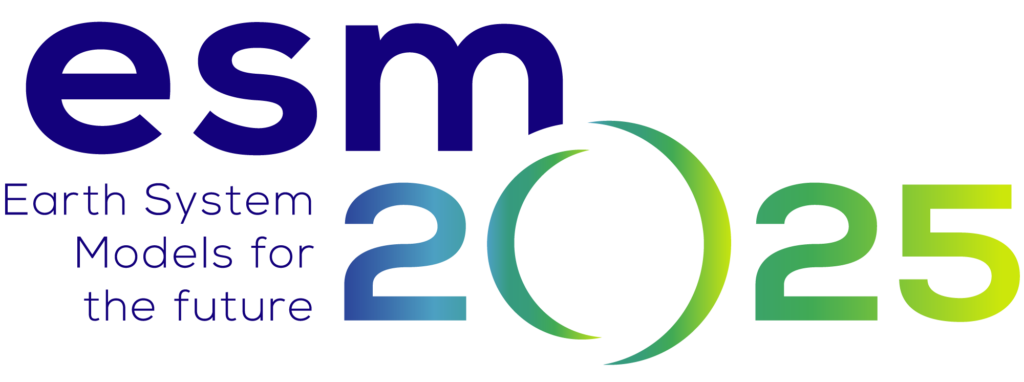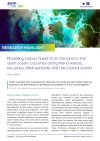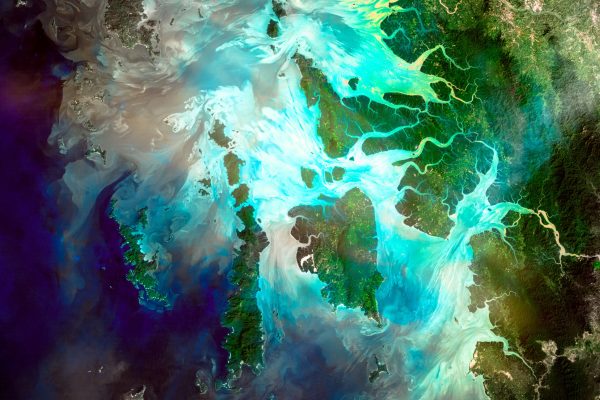
“Under scenarios with increasing CO2 emissions, the ocean and land carbon sinks are projected to be less effective at slowing the accumulation of CO2 in the atmosphere.”
IPCC WG1 AR6 Headline Statement from the Summary for Policymakers
THE GLOBAL CARBON CYCLE
Therefore, carbon cycle models and Earth system models are essential tools for our understanding of how carbon is stored and exchanged between its different reservoirs, and the partitioning between natural and anthropogenic fluxes. Hence, they are a central piece of global carbon-budgeting efforts, such as the IPCC and the Global Carbon Budget assessments, whose 2022 reports were recently presented at COP27.
MODELLING THE LAND-TO-OCEAN CARBON FLUXES
The ‘river pipeline’ model
Traditionally, conceptual models of the carbon cycle quantified carbon storage by the ocean and the land separately, with terra-firme (dry-land) ecosystems on land and the open ocean “viewed as silos that exchange CO2 only with the overlying atmosphere”. This view was also reflected in many state-of-the-art Earth System Models that do not account for the direct exchanges of carbon between land and ocean. Furthermore, when included in traditional views of the carbon cycle, the lateral exchanges between these two reservoirs were represented by the river pipeline model, which assumes a direct and passive flow of natural carbon from land to the open ocean.
This approach has two major drawbacks. On the one hand, it does not fully consider the transport and transformation of carbon along the ‘land-to-ocean aquatic continuum’ (LOAC), which links upland soils and the open ocean. The LOAC accounts for a variety of aquatic ecosystems that are connected by biogeochemical processes, including inland waters (streams, rivers, floodplains, lakes, ponds and reservoirs), estuaries (alluvial tide-dominated estuaries, small deltas, lagoons and fjords), tidal wetlands (mainly tidal marshes and mangroves) and continental shelf waters (shallow part of the ocean down to the shelf break ~ 200 m depth). The submerged vegetation, such as seagrass and macroalgae, is another important element of the LOAC ecosystems that is also overlooked by the river pipeline approach. Together with tidal wetlands, these ecosystems have a crucial role in the extraction of CO2 from the atmosphere, which they export laterally towards estuaries and continental shelf waters.
On the other hand, the river pipeline model assumes that only natural carbon is transported from land to the open ocean. Hence, it neglects the anthropogenic perturbations in LOAC processes. Due to both these drawbacks, the traditional approach used for separating natural and anthropogenic CO2 fluxes from total CO2 fluxes estimated from observational data – essential for global carbon-budgeting efforts – was not consistent with our current knowledge of the LOAC processes.
The new LOAC carbon loop model
To overcome the important limitations of the river pipeline model, a team of researchers from Belgium, the United States and France, led by ESM2025 researcher Pierre Regnier, recently proposed a new conceptual model for the land-to-ocean carbon fluxes. This new model accounts for the various natural processes and ecosystems of the land-to-ocean aquatic continuum, and their contribution to the transport and transformation of natural and anthropogenic carbon from land to the open ocean. In the land part, it considers the terra-firme ecosystems separately from inland waters, and it comprises the overlooked contributions of coastal ocean ecosystems (such as estuaries, tidal wetlands and continental shelf waters), thus including ‘blue carbon’ ecosystems, known for their important role in taking up CO2 from the atmosphere. This new conceptual model of the global carbon cycle is composed by one long-range carbon loop that connects terra-firme ecosystems to the open ocean, and by two short-range carbon loops: an upstream loop, connecting terra-fime ecosystems to inland waters, and a downstream loop, connecting tidal wetlands and shelf waters to the open ocean.
This new view highlights the fact that not all the land-to-ocean carbon fluxes come directly from terra-firme ecosystems, but there is a significant fraction coming from vegetated coastal and nearshore aquatic ecosystems. It finally allows us “to quantify each LOAC carbon flux and provide a full closure of the global carbon budget”, for both present-day conditions and pre-industrial times.
Quantifying LOAC carbon fluxes: a data and modelling challenge
The last decade has seen a huge boost in the assessment of the land-to-ocean carbon fluxes, especially for greenhouse gases. The new conceptual LOAC model thus builds on new, more constrained quantitative assessments of the LOAC fluxes, both spatially and, whenever available, temporally.
The researchers synthesised more than 100 individual studies of the various components of the LOAC. This proved to be a challenging task as it implied the integration of different types of data, across ecosystems, space and time. Moreover, information on the temporal coverage of observational data was often missing, data density changed significantly with time, and the integration and propagation of uncertainties presented a significant technical challenge. The anthropogenic contribution was even harder to track, due to the lack of data on the historical evolution of those fluxes at global-sale. Hence, the researchers had to rely on an aggregation of regionalized assessments of anthropogenic perturbations, on model-based estimates, and sometimes on expert judgement. Using model results was a challenge per se, as Earth System Models are only beginning to include the LOAC and do not yet provide a comprehensive, global-scale view of the magnitude of the anthropogenic perturbation. The overall process further implied working across different research communities and conciliating ocean and terrestrial ecosystem views, which was another arduous task.
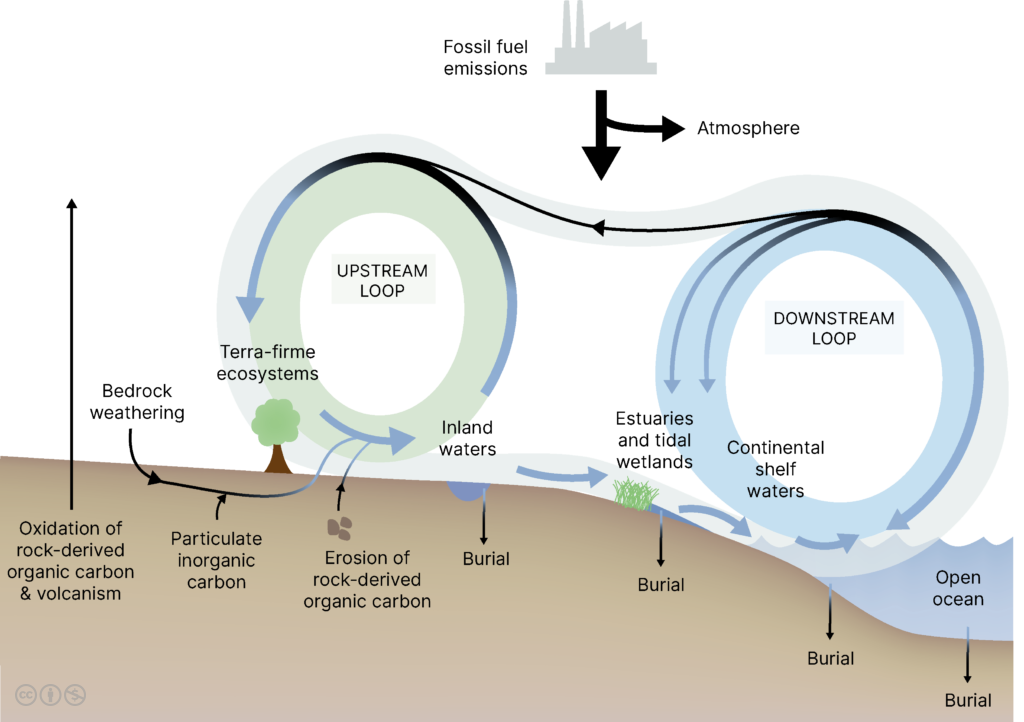
Present-day carbon cycling along the land-to-ocean aquatic continuum (adapted from Fig. 2a of Regnier et al. 2022).
IMPLICATIONS FOR THE GLOBAL CARBON CYCLE
The LOAC model provides a new framework for more detailed estimates of the carbon fluxes between the different reservoirs and ecosystems of the aquatic continuum. It considers present-day fluxes and their anthropogenic perturbation, and thus allows to reconstruct pre-industrial fluxes. It also furthers our understanding of how the carbon cycle has been changing due to human activity. Therefore, this new view of the LOAC has some remarkable implications for our knowledge of the global carbon cycle.
The buffer effect of the upstream short-range loop
Instead of the classical single long-range loop from the land to the open ocean, the new model considers two additional short-range loops. These loops “disconnect” the land and the open ocean, in terms of carbon fluxes.
The upstream short-range loop, which transfers carbon from terra-firme ecosystems to inland waters, is characterised by a very efficient turnover. “It recycles about 80% of the carbon leached from terra-firme ecosystems back to the atmosphere before reaching the river–estuary interface, minimising the transfer of carbon from the land to the ocean.” Increasing anthropogenic CO2 emissions has resulted in a greater uptake of carbon by the land (the “land carbon sink”), which in turn has enhanced the leaching of carbon from terra-firme ecosystems to inland waters, sometimes exacerbated by the perturbation in the hydrological cycle. Processes such as river damming also enhance the trapping of carbon in inland waters. In addition, inland waters, with low pH (compared to coastal waters) have a small capacity to fix the CO2 released from soils or produced in-situ, which is thus rapidly outgassed back into the atmosphere, further enhancing the efficiency of the upstream loop. This implies that the upstream short-range loop is actually working like a buffer, keeping a significant part of the (anthropogenic) carbon released from land from being exported to the open ocean through the global river network.
The blue-carbon ecosystems of the downstream loop
Due to the very efficient upstream short-range loop, river export of carbon to the open ocean has not significantly increased since pre-industrial times. However, accounting for all the LOAC carbon fluxes, Regnier et al. found that a significant fraction of the carbon fixed by blue carbon ecosystems of the downstream loop is subsequently transported to the open ocean. During pre-industrial times, this downstream short-range loop was more active than today and sustained part of the pre-industrial open-ocean outgassing. The uptake of CO2 by blue carbon ecosystems has now decreased by about 50%, due to human-induced disturbances, most notably from conversion of these highly valuable vegetated habitats. These ecosystems, and their crucial role in CO2 uptake, are ever more at stake if left unprotected from, e.g., climate disturbances such as cyclones, sea level rise, coastal development, and pollution.
An important contribution to global carbon-budgeting efforts
By detailing the reservoirs and fluxes of the land-to-ocean aquatic continuum, the study of Regnier et al. provides the first quantitative and comprehensive assessment of the pre-industrial carbon fluxes and storage by the open ocean relying on a LOAC perspective. The pre-industrial (natural) ocean outgassing estimate finally provides a means (values and associated uncertainty) to reconcile assessments of the anthropogenic ocean sink derived from observations (computed as measured present-day flux plus LOAC-derived pre-industrial outgassing) with model-derived estimates, a result of paramount importance for global carbon-budgeting efforts.
Another consequential contribution of this work concerns the impact of LOAC fluxes on the partitioning of anthropogenic carbon storage between the land and the ocean. Due to LOAC transfers, it was found that the land and open ocean respectively store less and more anthropogenic carbon than in classical assessments such as those synthesised by the IPCC or the Global Carbon Project. In addition, a significant fraction of the anthropogenic carbon leached from terra-firme ecosystems remains stored in the sediments of the LOAC.
FUTURE CHALLENGES
Our knowledge of the LOAC reservoirs and fluxes at a global scale remains limited, especially regarding the anthropogenic perturbation. The large regional variability of LOAC fluxes, the limited knowledge regarding the temporal variability that can be extracted from existing data, as well as a critical need for more observation-based evidence in poorly surveyed ecosystems and regions, remain important challenges to constrain the spatiotemporal variability in present-day fluxes and their anthropogenic perturbations.
Models can help palliate this difficulty, and, hence, “another priority is to improve the representation of the missing processes and LOAC compartments in Earth System Models and introduce a full coupling of the land and ocean carbon fluxes in global simulations.”
Including LOAC carbon fluxes in Earth System Models
This is precisely an important target in the ESM2025 project, which aims to include the land-to-ocean carbon fluxes along the global river network (including the interconnected floodplains). Significant progress has already been achieved in this direction, with a full coupling of inland water processes in the land surface scheme of an Earth System Model and a first assessment of the anthropogenic perturbations of the LOAC carbon fluxes over the historical period (1850-present). This includes a quantification of the changing carbon export fluxes to the ocean, which will later on be connected with a global ocean biogeochemical model. Further work also includes projections of future LOAC carbon fluxes under different socio-economic development scenarios, and the inclusion of the LOAC nitrogen cycle in Earth System Models.
Authors: Mariana Rocha, Pierre Regnier
ESM2025 researchers working on this topic: Minna Ma and Haicheng Zhang (Université Libre de Bruxelles, Belgium)
